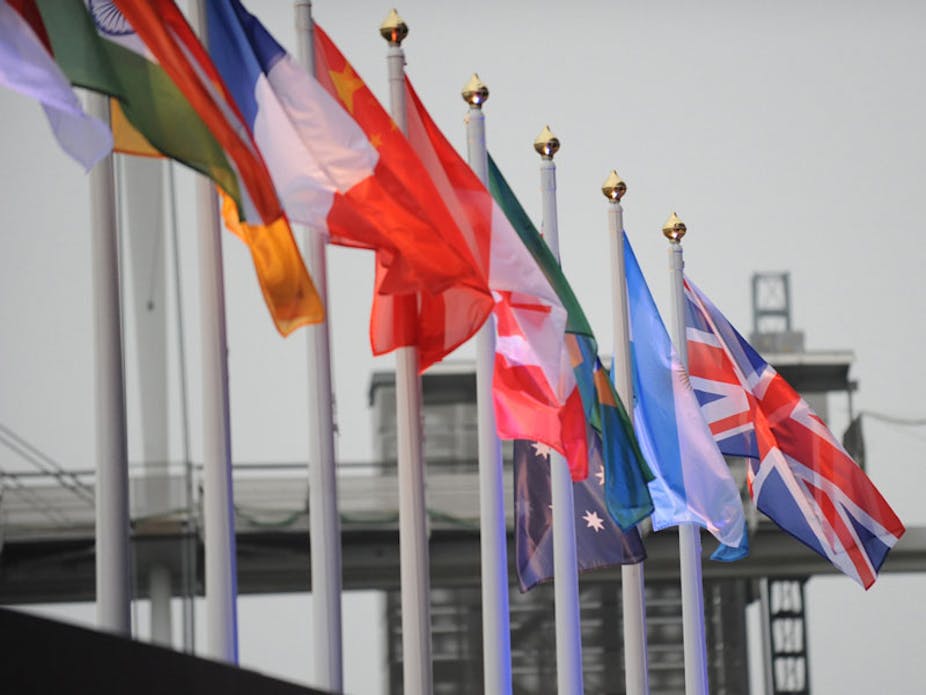As G20 finance ministers and central bank chiefs prepare to meet in Sydney this weekend, leading corporate figures known as the B20 will meet separately with major global investors to discuss the need for infrastructure investment to boost growth. The meeting comes as treasurer Joe Hockey calls for G20 members to commit to ‘hard’ global growth targets.
More than five years after the global financial crisis, the world economy is performing well below its potential, largely due to problems caused by the governments of the Eurozone and the United States.
The future of the Euro hangs in the balance while Germany refuses to stimulate growth or adopt policies that could reduce the unsustainable debt burden of the weakest European economies. The United States has shuffled along the edge of a fiscal cliff for several years while spending far too little on the public goods needed to underpin its future.
The uncertainty caused by such brinkmanship has deterred private investment and led to a huge accumulation of savings, driving real interest rates into negative territory. The remedy for inducing a recovery of confidence, demand and growth has been well known since the 1930s. It was applied effectively by G20 governments in 2009. Facing the danger of a global depression, all of them agreed to adopt fiscal policies to stimulate demand in their economies.
However, once the immediate threat had passed, excessive concern about long-term debt led too many G20 governments to apply their fiscal brakes far too soon. As we enter 2014, it is becoming unsustainable to counter perversely contractionary fiscal policy by unprecedented monetary policy easing.
There are many ways G20 governments can improve their productivity, including more efficient management of product and factor markets. They should also agree on smarter fiscal policies.
If the leaders of the world’s largest economies make a determined effort to accelerate sound investments in infrastructure, that can create a large, and potentially rapidly growing, source of effective demand which does not require unsustainable borrowing. Sound investment in transport and communications, energy and urban services can pay for itself by adding to long-term productive potential.
To be big enough to revive confidence in sustained global recovery, such new stimulus to needs to be coordinated – no economy can do it alone, hence the opportunity for G20 coordination. To be sustainable, it will also be essential to attract private as well as public sector investment. To be commercially attractive and fiscally affordable, infrastructure investments must be selected carefully.
There is no shortage of good investment opportunities. The OECD estimates that global infrastructure requirements over the next two decades will be around US$50 trillion. The ADB estimates that developing Asian economies need to invest $US8 trillion in this decade to keep pace with expected infrastructure needs. The supply of savings is more than adequate to begin to fill some of this unmet demand.

Investments in better transport and communications among economies is, at the same time, the most efficient way to promote deep economic integration. The prospective gains from improving transport and communications among economies now outweigh, massively, the potential gains from negotiating free trade areas. Connecting low income economies to global markets is one of the most effective ways for the G20 to prove its value to the rest of the world.
It will not be easy to fix the massive market failure which currently allows massive savings to co-exist with huge gaps in infrastructure. Many constraints will need to be addressed to accelerate investment, especially to attract investment in infrastructure from private savings. But limits of skill, institutional and administrative capacity and problems of financial intermediation can all be overcome gradually.
G20 governments are already looking for ways to help steer more capital towards investment in infrastructure, but there is a risk that they will not go further than enthusiastic statements and more and more studies. By far the most effective way to find ways past constraints is to learn from experience – to set out a strategy for actual investments, starting with some pilot projects large enough to attract high-level political commitment to delivering them.
The Asia Pacific Economic Cooperation (APEC) is setting a good example for the G20. Asia Pacific leaders have adopted a long-term APEC Framework on Connectivity. Within that framework, targets for physical connectivity include better regional transport and energy networks and universal broadband access. Institutional connectivity will aim for better cross-border financial cooperation and more coherent approaches to economic regulation.
People-to-people links can be enhanced by expanding the coverage of the successful APEC Business Travel Card and by taking advantage of the information technology revolution in higher education.
Multilateral development banks can help to mobilise finance for the necessary investments from global capital markets. Both the Asian Development Bank and the World Bank are designed for such financial intermediation. The incentive for them to do a lot more has been heightened by China’s decision to establish a new Asian Infrastructure Investment Bank (AIIB).
As a new institution, the AIIB will want to make its mark by moving rapidly to finance some significant projects which promise sound economic rates of return. Potential examples include a multilateral program to achieve a significant, measurable improvement in the efficiency of some major Asia Pacific ports and airports in the next ten years and a massive upgrading of connectivity between Southeast Asia, Northeast Asia and South Asia, taking advantage of Myanmar’s gradual opening to the outside world.

